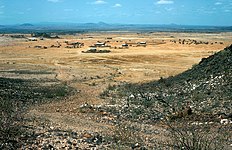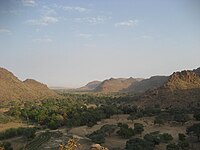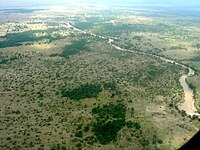Boual ka Bifie
| Boual ka Bifie | |
|---|---|
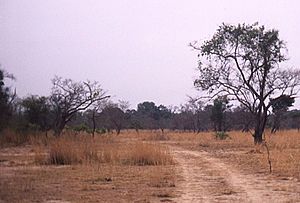 A road in Yemet surrounded by acacia, a common sight in the Boual ka Bifie. | |
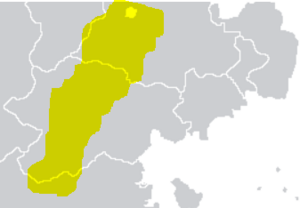 The extent of the Boual ka Bifie in Bahia. | |
| Ecology | |
| Realm | Bahiotropical |
| Biome | Tropical and subtropical grasslands, savannas, and shrublands |
| Borders | Fersi desert, Ouloumic highlands |
| Geography | |
| Countries | Dezevau, Mabifia, Yemet and Zorasan |
The Boual ka Bifie (Talanzi: የቢፊ ነፋሳት ሜዳ, Yebīfī Nefasati Mēda ) is the geographic region to the southeast of the Fersi desert that stretches across western Bahia, particularly Mabifia and Yemet. The name is Ndjarendie in origin, and can be translated as "the Plain of the Bifi" which makes reference to the seasonal trade winds which are highly important for the livelihoods of its inhabitants.
While the name has historically stood for the entire geographic region marked by the bifi, in modern usage it is often restricted to the highland plains of Mabifia. This is due to the political connotations of using the Ndjarendie language, as well as the etymology of Mabifia which refers to the region.
Culture
The traditional livelihood for much of the Boual ka Bifie is based around semi-nomadic pastoralism which uses transhumance in order to maximise the efficiency of grazing whereby the herders will pasture their herds in the high quality soil of the outer Boual during the monsoon season, profiting from its rich soils, before moving their herds to the inner Boual with the advent of the Bifi as the soils there are less rich but sustain more growth. Several traditional rituals have emerged out of this movement, which are rooted in fetishist beliefs but which have survived the Irfanisation of much of the Boual ka Bifie.
Despite being the dominant religion of the Boual ka Bifie, Irfan here is highly different from the more legalist practices of Rahelia and Zorasan. This is particularly notable among the herder groups, who often preserve many pre-Irfanic practices like female genital mutilation and worship of saints and ancestors. This has led to conflict between more conservative Irfanists, who deem such practices to be heresy.
Geography
The Boual ka Bifie is a large plateau interspersed by several river valleys, the most notable of these being the Maaïo river in Mabifia and Name river in Yemet. It is covered primarily by grassland, acacia savanna, gallery forest and some more wooded areas. A notable feature of the region is the presence of vast rock formations, which have been formed due to the heavy erosion of hills and other geographic features by the strong Bifi winds which bear clouds of dust from the Fersi desert.
The Boual ka Bifie acts as a transition zone between the Fersi desert to the north and the rainforests of coastal Bahia. Its average temperatures are high, ranging from the low 20s in the colder month to the 30s in the hottest months. This can change drastically during the day, with overnight temperatures often far lower than those during the day. The Boual ka Bifie is most influenced by two seasons, the winter monsoon which brings precipitation and the hot and dry Bifi in the summer. Precipitation is often very high in the monsoon season, leading the region's fauna to have adapted to irregular water supply. In the monsoon season, flooding can occur as dry river bed and natural reservoirs are unable to cope with the quantity of rainfall.
Forest on the banks of the ?? river.
Farkí valley in Makania.
Acacia savanna in Kangesare Department, Mabifia.
Gallery forest along the banks of the Noura river, Mabifia.
History
The Boual ka Bifie is often considered to be the origin point of homo sapiens, as it is here that the oldest fossil traces of modern humans have been discovered. Agriculture was introduced through contacts with the Ziba of modern-day Dezevau, beginning the Saretic period of Bahian civilisation. However, as the climate changed and became hotter, agriculture was limited and livelihoods began to shift towards pastoralism.
Middle ages
Irfan arrived in the region during the First Heavenly Dominion, spread by Rahelian merchants who crossed the Fersi desert in the goal of trading for gold and ivory. These merchants were soon followed by the first Mourâhiline, raiders who attacked with the predominantly fetishist Ndjarendie Jaoudesares and Mirite Douwanis. The religion spread to some of these tribal settlements through a mixture of armed force and persuasion.
In the 9th century CE, prompted by a combination of poor grazing conditions and religious zeal, the Founagé Dominion of Heaven was declared by Almami Fakruddin Bâ and began to expand southeast. This state was the first of many Razzia states, which were the catalysts of the Bahian Consolidation and advent of the Houregic system. The Boual ka Bifie would host several key Houregic entities, most famously the Houregery of Kambou which was one of the major Axial Houregeries of the Djaladjie.
Colonisation and modern day
As Houregic society fell into its decline, the Boual ka Bifie came under the control of Euclean colonial powers. The Toubacterie saw the erosion of much of the traditional lifestyles of the Boualic cultures, which lead to its relevance during the Sougoulie. In the modern era, the region is an area of dispute due to the Herder-farmer conflicts in the Boual ka Bifie where desertification has led to violence between nomadic pastoralists and sedentary farmers.

